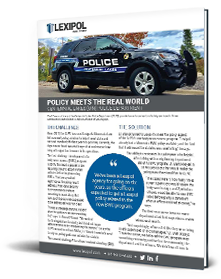The 17 sworn officers of the Centennial Lakes Police Department (CLPD) provide law enforcement and safety services to three communities located about 20 miles northeast of Minneapolis.
The Challenge
Since 2011, the CLPD has used Lexipol’s Minnesota Law Enforcement policy solution to help it meet state and national standards for best practice policing. Recently, the department faced two challenges that underscore how integral Lexipol has become to its operations.
The first challenge: development of a body-worn camera (BWC) program. In 2016, Minnesota passed a law requiring cities to adopt written policies before implementing BWCs. The law specified eight topics the policy must address, from data security to circumstances where recording is mandatory. But how such topics were supposed to be addressed was not clear.
“It was a one-page statute; it didn’t give the guidance we were waiting for,” says Lt. Russell Blanck. “We waited for the legislature to clarify, but it did not issue administrative rules interpreting the statute.” So as the CLPD moved to roll out BWCs, Lt. Blanck knew he’d need to rely on policy guidance outside the statute.
The second challenge? An officer-involved shooting (OIS).
The Solution
Lt. Blanck turned to Lexipol to meet the policy aspect of the CLPD’s new body-worn camera program. “Lexipol already had a Minnesota BWC policy available, and the fact that it addressed the statutes was comforting,” he says.
The ability to customize the policy was also helpful. After talking with a neighboring department about its BWC program, Lt. Blanck keyed in on two provisions that would make the policy more functional for the CLPD. “The issues were 1) how many times a year supervisors would review the body cam footage, and 2) whether officers would be able to view BWC video before giving a statement after an officer-involved shooting,” he says.
The first issue arose because some departments had their supervisors review videos each month.
“Not surprisingly, officers felt like they were being overly supervised or micromanaged,” Lt. Blanck says. “From the outset, we believed the BWC program was something extremely positive for the community, the department and the officers. We didn’t want there to be any feelings of mistrust. As such, we modified the policy to avoid ‘over-supervision.’”
The second issue—whether to allow officers to view the video prior to giving a statement—was causing much controversy in Minnesota. It was important to the CLPD to have its officers’ support of the new policy. However, the department also wanted its procedures to be in line with those of the Minnesota Bureau of Criminal Apprehension (BCA), the agency which investigates many of the OISs in the state.
“When the BCA adopted the position that, where the officer’s department allows the officer to see the video before giving a statement or writing a report, they will also allow the officer to view the video, we knew we had a workable solution,” Lt. Blanck says. “So we incorporated that into our policy, which resolved an issue that was already being litigated by at least one other department. As a result, we received an endorsement from the union to use the Lexipol policy as modified.”
With the policy approved, rollout proceeded smoothly. “We’ve been a Lexipol agency for going on six years, so the officers expected to get a Lexipol policy related to the new BWC program,” Lt. Blanck says. “We also utilize the Daily Training Bulletins (DTBs) heavily, so my officers expected those too.”
A couple months before the BWC program went live, Lt. Blanck started issuing DTBs related to BWCs to familiarize officers with some of the scenarios they would need to work through with the cameras.
The Results
The CLPD’s BWC program went live in June 2017; in December, a CLPD officer was involved in a shooting. Lt. Blanck says this event underscored the benefit of having Lexipol policies in place. “We pulled our OIS policy first thing,” he says. “We found it extremely helpful. It provided a roadmap of what needs to be done and who is going to do it.”
The policies were also helpful for the subsequent investigation. “The issue of being able to view BWC video is addressed in both our OIS and our BWC policies,” Lt. Blanck says. “When the investigator came in, he was pleased to see the policies were in sync.”
The CLPD’s experience illustrates how Lexipol assists agencies in bringing on new programs by providing comprehensive policy, the ability to customize the policy, training to help familiarize officers with the policy before it’s effective, and clear language that guides leaders following critical incidents. “We tell the public quite often, if you hire the right people and you give them the right supervision, the right training, the right equipment and the right policies, the right things are going to happen,” Lt. Blanck says. For the CLPD, Lexipol has become interwoven into this equation for success.
We're committed to protecting you and your community.
Fill out the form below to contact us today.
